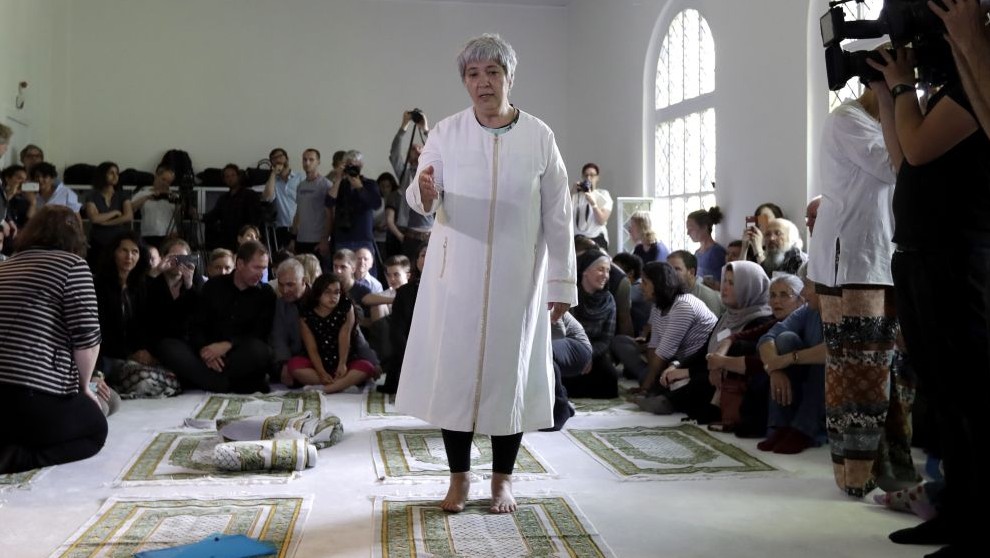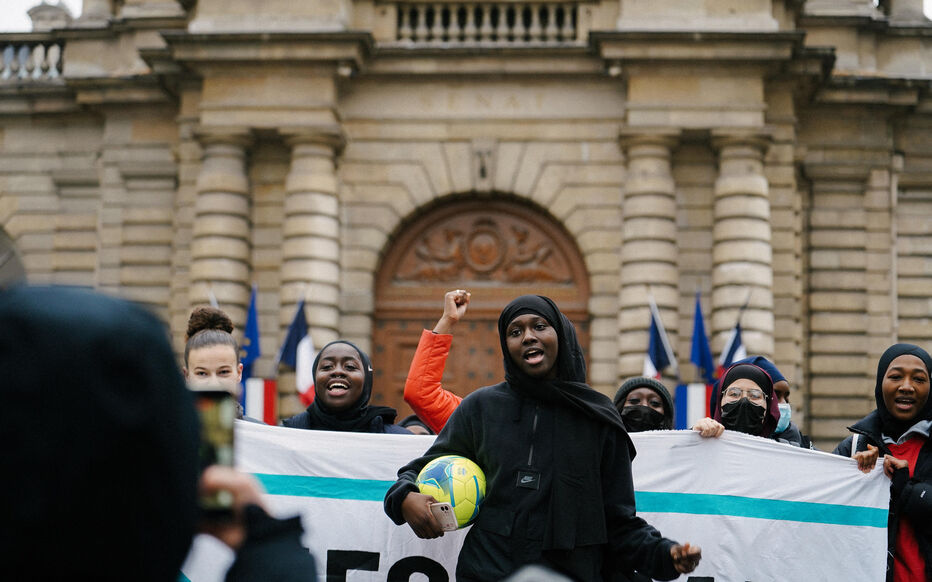Seyran Ateş, controversial founder of an avowedly ‘liberal’, gender-equal mosque in Berlin at which she serves as female Imam, has been faced with disbelief at her most recent comments on the Muslim headscarf.
Women’s rights lawyer turned to the religious field
Ateş made a name for herself in the 1990s as a lawyer defending women’s rights. In particular, she represented many Muslim women who went to court against their abusive husbands. Her activism and her strong public persona cost Ateş dearly: an assassination attempt nearly left her dead, and she had to retreat from the public eye for a few years.
Yet not only has Ateş since returned to the legal field; in recent years, she has become increasingly involved in religious and theological debates, for instance by attempting to initiate a pan-European citizens’ movement focused on combating ‘political and religious extremism’.1
And in 2017, she founded the Ibn Rushd-Goethe mosque in Berlin, assuming the position of Imam. The mosque project has been met with open hostility particularly from religious authorities in Turkey and Egypt. While domestic German Muslim voices were also sceptical of the project, its overall impact has been negligible and attendance at religious services low.
Springboard for a heightened public profile
Nevertheless, the mosque project has relaunched Ateş’ career as a public persona; indeed, the project itself has been so centred on Ateş that it has at times been difficult to distinguish earnest desire to mount a religious and spiritual project from Ateş’ own shrewd attempts at self-marketing.
Ateş subsequently re-emerged as the darling of conservative and secularist media circles. She became a much sought-after commentator on ‘religious extremism’ and ‘Muslim reform’, despite her complete lack of theological or religious credentials.
The controversial nature of her public persona have generally overshadowed whatever substantive contribution Ateş has sought to make to contemporary social and political debates. Many German Muslims who take an interest in these discussions are likely to see Seyran Ateş as a prime example of ‘tokenism’; i.e. as the ostentatious ‘Muslim voice’ lending legitimacy to Islamophobic agendas.
The hijab as a symbol of political Islam.
Speaking to the Austrian Kurier newspaper, Ateş denounced the “extreme influence of political Islam” in Europe; an influence which, according to her, manifests itself in the growing willingness of European political elites to abandon the Universal Declaration on Human Rights (UDHR) in favour of an Islamist rights catalogue.
According to Ateş, the increasing prowess of political Islam in European societies is also leading to the growing prevalence of the headscarf, even among children. (Empirical data tend to disprove or at least complicate this claim: research shows that so-called second- or third-generation immigrants of Muslim faith in Europe are significantly less likely to wear the hijab or a comparable headcovering than their mothers.)
Muslim women ‘paid’ to wear the hijab
In her interview, Ateş went on to claim that Muslim women living in Germany were paid in order to wear a hijab. “I cannot prove it yet. But when you go into the relevant milieu, you learn this. Cleaning ladies in Germany receive 100 Euros more in pay if they wear a headscarf.”
Referring to ongoing court battles in Germany surrounding Muslim women’s right to wear the hijab in public employment, Ateş asserted: “That’s only the tip of the iceberg. Students are also paid for it – also in order to go to court, to sue for the right to a headscarf. We cannot prove it yet but at some point these women will talk.”2
Muslim women react on Twitter
These unfounded claims were met with disbelief and ridicule among German-speaking Muslims. In particular, many Muslim women took to Twitter under the hashtag #whereismymoney to make fun of Ateş’ insinuation that they were paid in order to wear the hijab.
“How I fund my coffee addiction? Well, with my hijab!”, one user tweeted.
Wie ich meine Kaffeesucht finanziere? Na durch mein Kopftuch! #whereismymoney #seyranates
— Esim von Goethe (@esimvongoethe) March 8, 2018
Austrian activist Dudu Kücükgöl tweeted a picture of a woman under a money tree, writing: “This is how I collect my ‘headscarf bonus’ at the end of the month from Turkey, Saudi Arabia & Iran. If there are more authorities where I can apply, please tell me! Can I have my claims from previous years recognised?! I also accept gold bars and diamonds as payment!”
So sammle ich dann am Ende des Monats meinen „Kopftuch-Bonus“ aus der Türkei, Saudi Arabien & dem Iran ein. Wenns weitere Stellen zum beantragen gibt, bitte dringend um Auskunft! Kann man Vorjahre geltend machen?! Akzeptiere auch Goldbarren & Diamanten als Bezahlung! pic.twitter.com/Jx4ieVbmYi
— Dudu Kücükgöl (@duduhier) March 7, 2018
Another woman wrote a mock letter to the “headscarf authority”, complaining that, “in spite of assiduous wearing of the headscarf, no in-payment was registered on my bank account. […] I call upon one last time you to arrange the payment until March 8!” Failure to do so, she asserted, would lead her to hire Seyran Ateş as a lawyer and go to court against the headscarf authority in order to obtain her earnings.
Sehr geehrte Kopftuchbehörde,trotz fleißigen Kopftuchtragens konnte ich bisher keinen Zahlungseingang auf meinem Konto…
Posted by Betül Ulusoy on Wednesday, March 7, 2018
Men also expressed their amusement: “Now I know, why my Mum always wears a headscarf when she leaves the house. She simply cashed in all these years without telling us anything.”
Jetzt weiß ich, warum meine Mama immer ein Kopftuch trägt, wenn sie das Haus verlässt. Hat die einfach jahrelang abgecasht ohne uns was zu sagen. #whereismymoney #SeyranAtes #FTW pic.twitter.com/YPAhL23IR5
— ali dönmez (@alidoenmez1) March 8, 2018
Noktara, a website offering a satirical take on current events from a Muslim perspective, went on to publish a spoof article claiming that Ateş herself was offering 100 Euros to every Muslim woman who would take off the hijab.3
Labour market disadvantages faced by hijab-wearing women
Of course the idea that Muslim women in Europe obtain significant labour market benefits from wearing a hijab seems hard to square with the facts. A 2015 study observed that in Germany Muslim women were significantly less likely than Muslim men to be in employment; a tendency exacerbated among those women wearing the hijab. The study’s authors could not measure the extent to which this was due to either conservative gender norms or to discrimination, or to both.4
Results from other European countries5 or the United States6 have drawn even more explicit attention to the labour market disadvantages of donning a hijab.
Quo vadis, Seyran Ateş?
Against this backdrop, many hijab-wearing women will see Seyran Ateş’ comments – made just in time for international women’s day – as an unwelcome distraction at best and as an outright insult at worst.
How Ateş sees these statements as being conducive to her ‘liberal’ Islamic project is difficult to determine. To be sure, her steadfast fight for women’s rights has often been courageous. Nor should her expertise on the misogyny prevalent in certain social milieus be denied.
Yet neither are these milieus transformed through Ateş’ ill-advised public pronouncements, nor are these statements a meaningful contribution to a public debate about the exclusion of Muslim women in society. If Ateş has expressed her dismay that few ordinary Muslims attend her mosque, she cannot sincerely hope to make her ‘liberal’ theological offering – whatever its merits might be – more attractive by statements such as those made in the Kurier newspaper.
Sources
https://kurier.at/politik/inland/imamin-ate-als-christin-wuerde-ich-protestieren/313.056.892 ↩
Haug, Sonja; Stichs, Anja (2015). “Muslimisches Leben in Deutschland – Zahl der Muslime, Arbeitsmarktintegration, Soziale Integration.” In Rohe, Enging, Khorchide, Özsoy, Schmid (eds.), Christentum und Islam in Deutschland: Grundlage, Perspektiven und Erfahrungen des Zusammenlebens. Freiburg: Herder. ↩
https://www.telegraph.co.uk/news/2016/08/11/hijab-wearing-muslim-women-being-passed-over-for-jobs-in-last-fo/ ↩
https://www.aclu.org/other/discrimination-against-muslim-women-fact-sheet ↩






